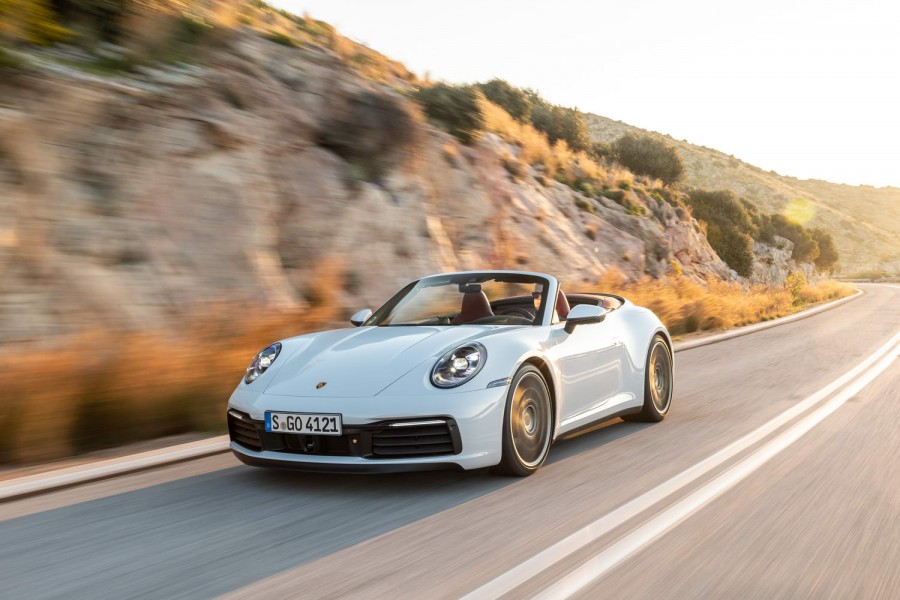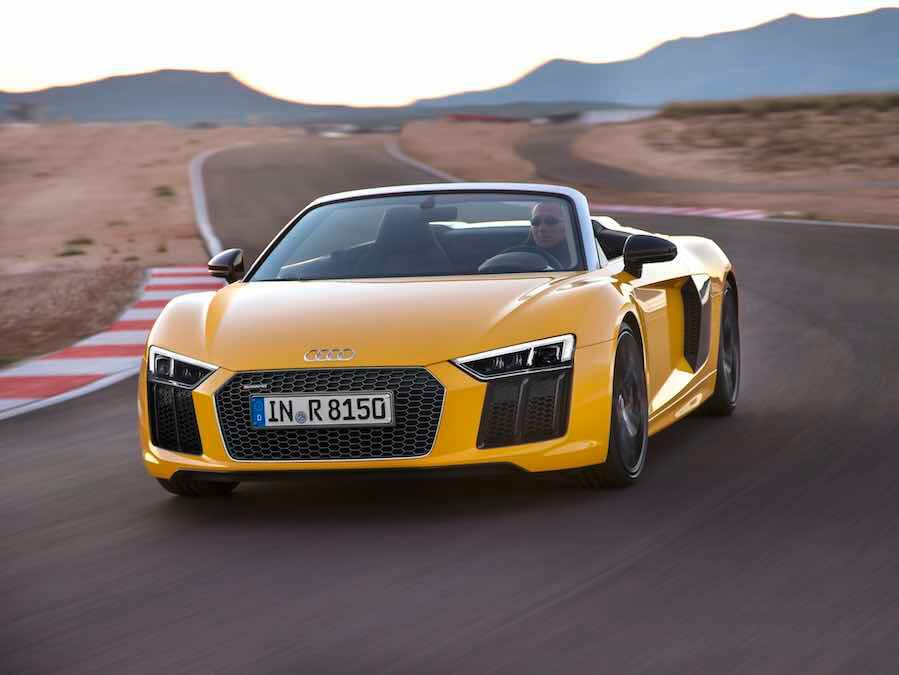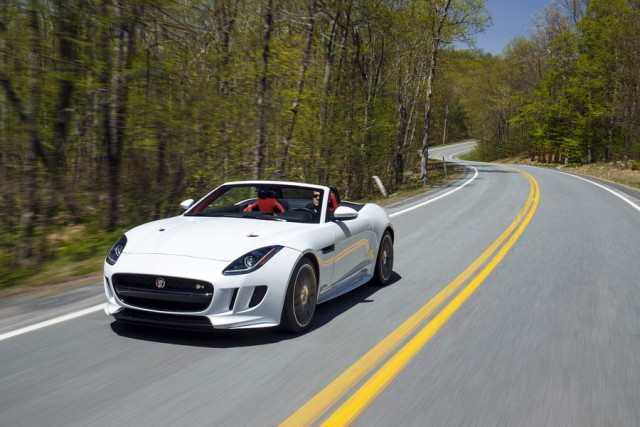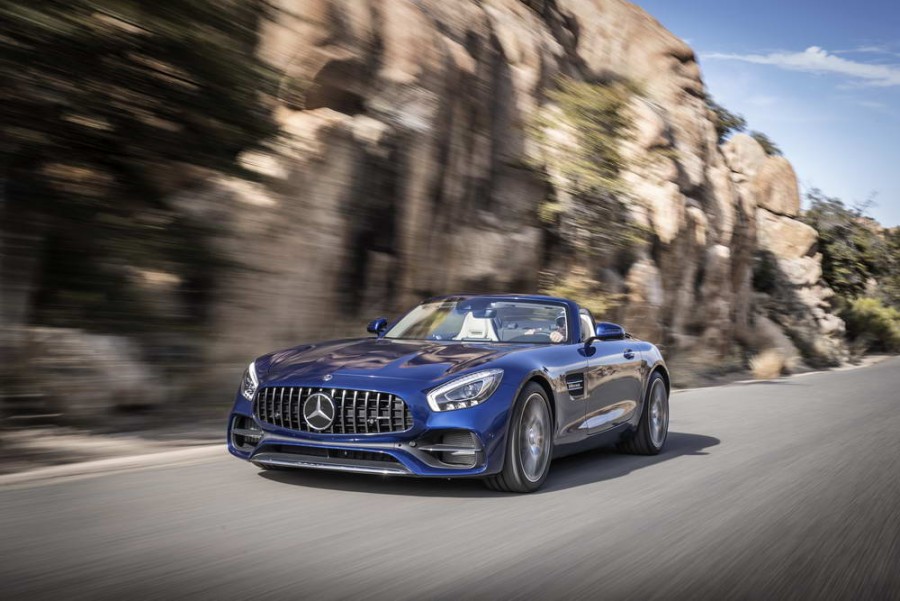There are a lot of models and variants of the latest '992' Porsche 911 on the way, but after our first drives of the Carrera S and Carrera 4S coupe models, now we get a go in the same two cars with their roofs lopped off. However, don't let that fact put you off, as the 992 Cabriolet is brilliant to drive.
In the metal
Take the 992-shape of Porsche 911 and remove the roof, and you're left with the familiar silhouette of the new Cabriolet - even though you've not actually seen the model before this point. Honestly, the look of the latest addition to the 992 family is not surprising in the slightest, but that's no reason to dismiss it out of hand, either. What you might not be so comfortable with is the slightly hump-backed appearance of the 911 Cabriolet; try to stash a folding roof (new design, lighter construction, acoustically terrific and capable of being folded away/unfurled fully electrically in just 12 seconds, even on the move at up to 50km/h) and a 3.0-litre flat-six engine in the back of a reasonably compact sports coupe means the Cabriolet looks a bit, er, bum-heavy in open-top guise. Viewed from dead-on rear, the height of the rear deck isn't much lower than the windscreen's header rail, so when you're following a 992 Cabrio it's not the car's best angle.
Exacerbating this is the current 911's rather divisive rear styling, with the full-width light strip and the very low-set licence plate. Couple it all together and we wouldn't say the Cabriolet is a beautiful car, but with a little more time in its company you start to appreciate the design a whole lot more. Further, the Sport Package brings in a diffuser at the back and also raises the number plate into the otherwise-smooth rear bumper, that one detail alone working wonders at taking the weight out of the 992 Cabriolet's rump. Throw in some lovely, bright colours - including Racing Yellow, Miami Blue and the formerly RS-model-specific Lizard Green - and the 911 open-top certainly has plenty of presence, even if you'll cede it nothing else. We've decided we like the look of it, although the Coupe is clearly the more visually pleasing derivative.
The cabin, however, is marvellous. That new instrument cluster, with the twin TFT screens that flank the analogue rev counter both being slightly angled inwards, makes the driver feel extra-special before the Porsche has so much as turned a wheel, while the (optional) GT Sport steering wheel is one of the best in the business: it's precisely round, just the right diameter and has a rim that isn't comically thick. The seating position is as you would expect of the company - perfect - and the new Porsche Communication Management interface for the infotainment immediately makes the preceding 991-generation 911's cabin look dated. OK, the rear seats in the 992 Cabriolet are bijou (that's the kind word...), but they're not totally unusable by smaller adults, and the front boot holds a mere 132 litres, so it's not the most practical car in the world... but then, what high-end convertible genuinely is practical? In all truth, the 911 beats many of its rivals by simply having those two small back seats, which can be pressed into service as a cargo area if needs be (assuming that you're just travelling two-up most of the time).
Driving it
Porsche offers the 'S'-specification 3.0-litre twin-turbo flat-six in the back of the 911 Cabriolet. With 450hp and 530Nm, this leads to performance that can best be described as 'seriously rapid'. Think back just three generations of 911 to the still-modern, 2001-launched '996' Turbo. And we do mean the full Turbo, with the capital T and everything. Upon its debut, its savagely ferocious acceleration stunned the world and you'd still call it a mighty fast machine even today, 18 years on from its arrival.
Yet, with 420hp, it couldn't hope to match the 992 Cabriolet. Even as the 'X50'-equipped performance motor, with power ramped up to 450hp, it could 'only' run 0-100km/h in 3.9 seconds and a top speed of 304km/h, which are the slowest stats the new open-top 911s can record. There are two drivetrain options in the range right now, the rear-wheel-drive Carrera S Cabriolet and then the Porsche Traction Management-equipped (PTM) all-wheel-drive Carrera 4S Cabriolet. Despite the AWD 911 Cabriolet being 50kg heavier than its two-wheel-drive sibling, it uses its additional traction advantages to record a marginally faster 0-100km/h time of 3.8 seconds (3.9 seconds for the Carrera S). However, equip either car with the Sport Chrono package and its attendant Sport Plus mode with launch control, and two-tenths tumbles off these times to 3.6 and 3.7 seconds accordingly. The top speeds of the two Cabriolets are both beyond the 300km/h barrier, the 4S maxing out at 304km/h and the Carrera S going a little further, to 306km/h.
Nevertheless, all this on-paper pub-boasting only half conveys just how ridiculously punchy the new Cabriolets are. Either one has immense traction (afforded by the rear placement of the engine) and seemingly limitless dry-weather grip, so you can just lean on that turbocharged motor's resources and hurtle for the horizon in a quite startling turn of speed. Like all the best turbocharged mills, the 3.0 in the 911 has both muscle and reach, so there's reward to be had both short-shifting it and riding out the 530Nm of midrange torque, or spinning it out to its 7,400rpm redline and listening to the flat-six sing.
Ah. Now. This is one area where we're not quite so enamoured with the 992 Cabriolet's dynamics. For all the whooshing and hissing and grumbling the blown-six emits, it never matches up to the hard-edged gargling of the normally aspirated 911 powerplants of old - sure, it gets louder as you rip past 5,000rpm and out to the upper reaches of the tacho, and it's certainly not an unpleasant noise that the 3.0-litre makes, but neither is it quite as exhilarating to listen to as it is to sit in while it's accelerating hard, feeling it squash you back in your seat.
No matter; the handling is exemplary. For a convertible like this, Porsche has done wonders to keep its roofless form structurally rigid and while you get a few tell-tale shudders from the Cabriolet's shell in the wake of really big compressions, or while you might be able to argue that it's not the finest Porsche for the avid track-day enthusiast, you'd be hard-pressed to fault it for the skill, composure and downright entertainment value it provides on the right road. The steering is magnificent; there's the slight sensation that the 2WD model has a slightly lighter, even more feel-rich set-up than the 4S, but you won't lament that at the wheel of the AWD 911 Cabriolet. Armed with that, and the sort of rock-solid body control that marks out all the greatest sports cars, you can flick the 992 into corners on the road while brimming with confidence, using the mighty traction to fire out of corners at enormous pace. Linking challenging bends together, with the hood down, it's hard to imagine anyone saying that the 911 Cabriolet's glittering driving experience is in any way disappointing.
It also functions wonderfully well as a fast cruiser, with impressive ride quality and good suppression of noise - particularly from the new hood - making it really comfortable to travel in. In its smoothest modes, the PDK is as good as any regular automatic and with its easy-going torque, the Carrera 4S Cabriolet conveys the impression that the open-top model is moving as close to the 'grand tourer' formula as a 911 ever has. This is not a bad thing, believe us, because - as we've already said - the Cabriolet has already demonstrated that its sports car genes are healthily preserved when you want to access them.
What you get for your money
Prices are yet to be confirmed exactly for the 911 Cabriolet in Ireland, but we reckon on the car starting at around €180,000. Obviously, this is hardly inexpensive, but all models do gain Porsche Adaptive Suspension Management, the PCM infotainment, an eight-speed automatic, a fully integrated and electrically operated wind deflector and leather upholstery, among much more. Naturally, as a Porsche, there will be a lengthy options list including things like rear-wheel steering, a 10mm-lower Sport chassis, the Sports exhaust system (fitted to our test cars, the easy way to spot this is if the 911 has two round, oval tailpipes - regular cars have quad exhausts, arranged in pairs either side of the rear valance) and even carbon-ceramic brakes (PCCB), all of which can push the price up, but in essence the 911 doesn't feel particularly overpriced at this sort of money.
Summary
There seems to be little drawback in going for the Cabriolet model of the Porsche 911 this time around, the petrolheads' usual sneering dismissal of open-top cars not being relevant here. This is a superb all-rounder, considering its age-old basis material: it's comfortable, it's thrilling to drive, it looks good (once you've acclimatised to it), it has a tremendous cabin and, of course, it has the sort of searing pace that you'd demand of a 911. Truly, it would seem like the Cabriolet, after 37 years of maturation, has finally come of age.





























